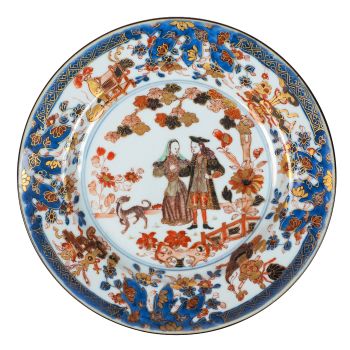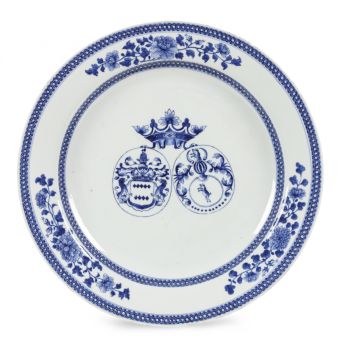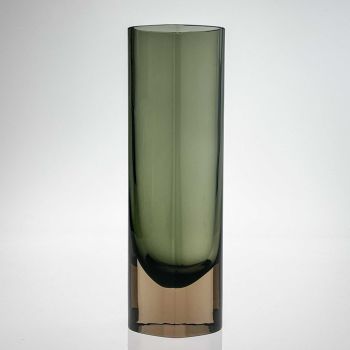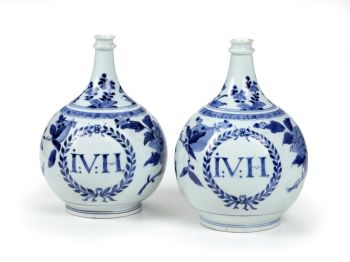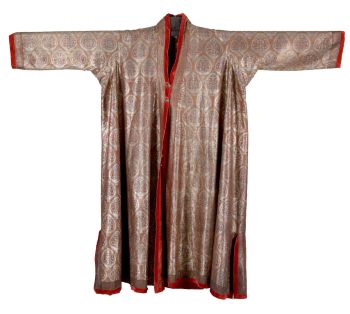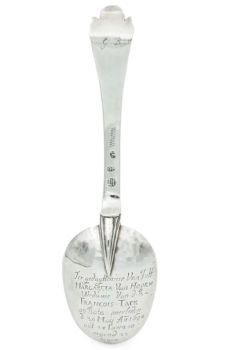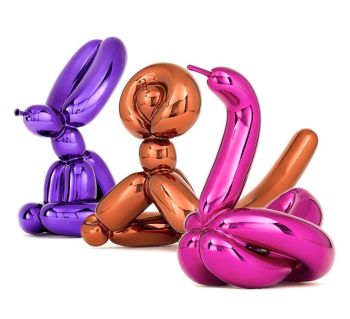A Chinese export 'famille verte' porcelain armorial dish with the coat-of-arms of Groningen 1700 - 1710
Unknown artist
Porcelain
38 cm
Price on request
Zebregs & Röell - Fine Art - Antiques
- About the artworkA Chinese export 'famille verte' porcelain armorial dish with the coat-of-arms of Groningen
Three styles of these so-called provincieborden or 'province' dishes were ordered by the Dutch in China between circa 1700 and 1720, each with the name and the coat-of-arms of a province or town in the Netherlands, England, France or Austrian-ruled Belgium. The present dish with the coat-of-arms of the city of Groningen belongs to the earliest decoration style.
This dish bears the coat-of-arms, a double-headed eagle, of the city of Groningen, as indicated in a banderole with the name Groeningen. Groningen is the most important city in the north of the Netherlands. From the moment it gained city rights in 1245 till the French era, being somewhat isolated from the centre of power in the west of the Netherlands, Groningen could be considered an independent Hanseatic city-state orientated towards north Germany. After 1594, the province (bearing the same name as the capital city) joined the Dutch Republic in its fight against Spain and later became a crucial hub for the Dutch West India Company in the north of the Netherlands. - About the artist
It might happen that an artist or maker is unknown.
Some works are not to be determined by whom it is made or it is made by (a group of) craftsmen. Examples are statues from the Ancient Time, furniture, mirroirs, or signatures that are not clear or readible but as well some works are not signed at all.
As well you can find the following description:
•“Attributed to ….” In their opinion probably a work by the artist, at least in part
•“Studio of ….” or “Workshop of” In their opinion a work executed in the studio or workshop of the artist, possibly under his supervision
•“Circle of ….” In their opinion a work of the period of the artist showing his influence, closely associated with the artist but not necessarily his pupil
•“Style of ….” or “Follower of ….” In their opinion a work executed in the artist’s style but not necessarily by a pupil; may be contemporary or nearly contemporary
•“Manner of ….” In their opinion a work in the style of the artist but of a later date
•“After ….” In their opinion a copy (of any date) of a work of the artist
•“Signed…”, “Dated….” or “Inscribed” In their opinion the work has been signed/dated/inscribed by the artist. The addition of a question mark indicates an element of doubt
•"With signature ….”, “With date ….”, “With inscription….” or “Bears signature/date/inscription” in their opinion the signature/ date/ inscription has been added by someone other than the artist
Are you interested in buying this artwork?
Artwork details
Related artworks
Unknown artist
A pair of angels Antwerp, 17th century, Carrara marble17th century
Price on requestFrederik Muller
1 - 4 / 12- 1 - 4 / 17
- 1 - 4 / 24
Unknown artist
An Indian silver filigree casket with hinged coverearly 20th
Price on requestZebregs & Röell - Fine Art - Antiques
Unknown artist
AN IVORY NETSUKE OF A DUTCHMAN FROLICKING WITH A SMALL BOY18th century
Price on requestZebregs & Röell - Fine Art - Antiques
Unknown artist
A MARINE IVORY NETSUKE OF A DUTCHMAN HOLDING A CHINESE FAN18th century
Price on requestZebregs & Röell - Fine Art - Antiques
Unknown artist
Dutchmen in Miniature18th century
Price on requestZebregs & Röell - Fine Art - Antiques
Unknown artist
The bell of the VOC fortress in Jaffna, Sri Lanka1747
Price on requestZebregs & Röell - Fine Art - Antiques
 Curated by
Curated byDanny Bree
Cornelis Anthonisz Theunissen
VERY RARE FIRST PRINTED MAP OF AMSTERDAM, A CITY ON THE RISE1544
€ 175.000Inter-Antiquariaat Mefferdt & De Jonge
 Curated by
Curated byDanny Bree
Unknown artist
AN UNUSUAL INDONESIAN LOBBED SILVER DISHlate 17th
Price on requestZebregs & Röell - Fine Art - Antiques
Unknown artist
A silver spoon commemorating Juff’ Margareta van Hoorn1656 - 1694
Price on requestZebregs & Röell - Fine Art - Antiques
1 - 4 / 24Samuel Dejong
Anatomia Blue Heritage, Hercules Open2017 - 2019
Price on requestVilla del Arte Galleries
 Curated by
Curated byGallerease Magazine
Unknown artist
Series of 6 Chinese cups and saucers (Yongzheng period)1722 - 1735
Price on requestKuipers Kunst & Antiek
1 - 4 / 24Unknown artist
A SMALL IVORY NETSUKE OF A DUTCHMAN WITH A DRUM1750 - 1800
Price on requestZebregs & Röell - Fine Art - Antiques
 Curated by
Curated byDanny Bree
1 - 4 / 12























